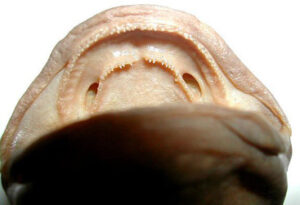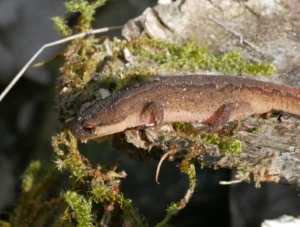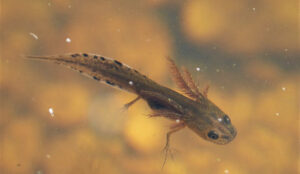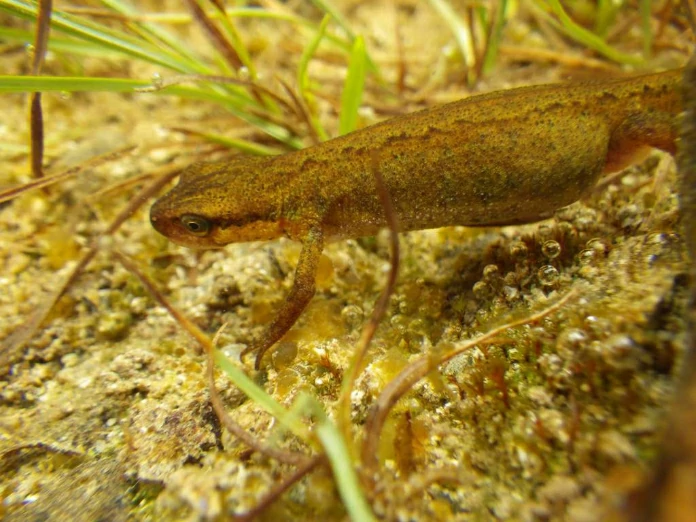Have you ever looked at a newt and noticed its tiny mouth opening and snapping at small insects? It moves so smoothly and almost silently that you might wonder: does it even have teeth? How does it grab its food?
Yes, newts have teeth, but they’re small, simple, and very different from ours. They aren’t made for chewing like human teeth. Instead, they’re sharp, needle-like tools made for catching prey and holding on tight as the food is swallowed whole.
What Newt Teeth Look Like
Newt teeth are tiny and pointed, lining the edges of the upper jaw. If you look closely with a magnifying glass, they almost look like rows of miniature spikes.

They aren’t for grinding or chewing. Their main job is simple: grip and hold.
When a newt snaps at a worm, insect, or tiny crustacean, the teeth make sure the prey doesn’t get away.
Some species even have slightly serrated edges, giving a little extra grip, like Velcro for tiny creatures.
How Do Newts Use Their Teeth to Eat?
Newts eat small animals whole, so teeth are less about cutting and more about catching.
Here’s what usually happens:
-
A newt spots prey, like a mosquito larva or tiny worm.
-
It moves its head quickly and snaps its mouth around the prey.
-
The teeth hold the prey in place while the newt swallows it whole.
Unlike humans, newts don’t chew. They use suction from the mouth and small movements to push food down the throat.
The teeth act like tiny anchors, stopping slippery worms from wriggling free.
Do Newts Use Teeth for Defense?
Mostly, no. Newts are gentle and slow-moving, and their teeth are too small to hurt much bigger animals. They’re just for eating.

However, if a newt is handled roughly, it might snap at a finger. The teeth may pinch a little, but they’re not dangerous.
Their purpose is survival in the pond, not fighting predators.
Are All Newt Teeth the Same?
No. Different species have slight differences depending on diet:
-
Smooth newts have very small, even teeth, perfect for soft-bodied prey.
-
Eastern newts have slightly longer teeth, helping them catch bigger insects.
-
Crested newts have more noticeable teeth, letting them tackle small aquatic worms and crustaceans efficiently.
Even with these differences, all newt teeth share the same goal: small, sharp, and designed to hold prey.
How Teeth Grow and Replace Themselves
Newt teeth are replaced all the time. Tiny teeth at the edges wear down or break, and new ones grow in.
This keeps the newt ready for each meal. Imagine a tiny conveyor belt of teeth quietly making sure the newt can always catch food.
Do Larval Newts Have Teeth?
Even the youngest newts, still larvae with gills waving in the water, have tiny teeth.

These teeth are especially important because larvae eat plankton, small crustaceans, and microscopic worms that slip easily through gills.
The teeth help larvae hold onto prey long enough to swallow. Without them, young newts would struggle to eat and grow.
How Teeth Work With Other Hunting Tools
Newts rely on more than teeth to catch food:
-
Eyes: Large and sharp, perfect for spotting movement in dim water.
-
Tongue: Sticky and quick, helping push food into the mouth.
-
Skin sensitivity: Can feel tiny vibrations in water, hinting at nearby prey.
Teeth are the last step in this system, a final line making sure once prey is caught, it doesn’t escape.
Do Newts Bite Humans?
This is a common question. If you pick up a newt, it may snap at your finger. The pinch is harmless because the teeth are tiny.
Newts don’t attack in defense, they’re shy, slow, and prefer to escape. Their teeth are for eating, not fighting.
How Teeth Affect a Newt’s Survival
Teeth may be small, but they’re very important:
-
Catch prey efficiently: Small insects, worms, and larvae are slippery. Teeth stop them from escaping.
-
Eat consistently: Healthy teeth mean the newt can feed every day and grow properly.
-
Support all life stages: From larvae to adult, teeth are used at every feeding stage.
Without them, newts would struggle to get enough food, which affects growth, health, and even reproduction.
Conclusion
So, do newts have teeth? Yes, and they’re perfectly built for catching and holding small prey.
Tiny, sharp, and constantly replaced, they’re a simple but essential tool for survival.
Newt teeth aren’t scary, they’re just functional. They don’t chew, they don’t fight, and they don’t hurt humans.
Instead, they quietly do their job every day, helping newts grow from larvae in the pond to adults crawling across forest floors or gliding through water.
Next time you see a newt snap at a tiny insect, take a moment to notice those small teeth.
They may be tiny, but they play a huge role in a newt’s life.
Hi, my name is Ezra Mushala, i have been interested animals all my life. I am the main author and editor here at snakeinformer.com.

